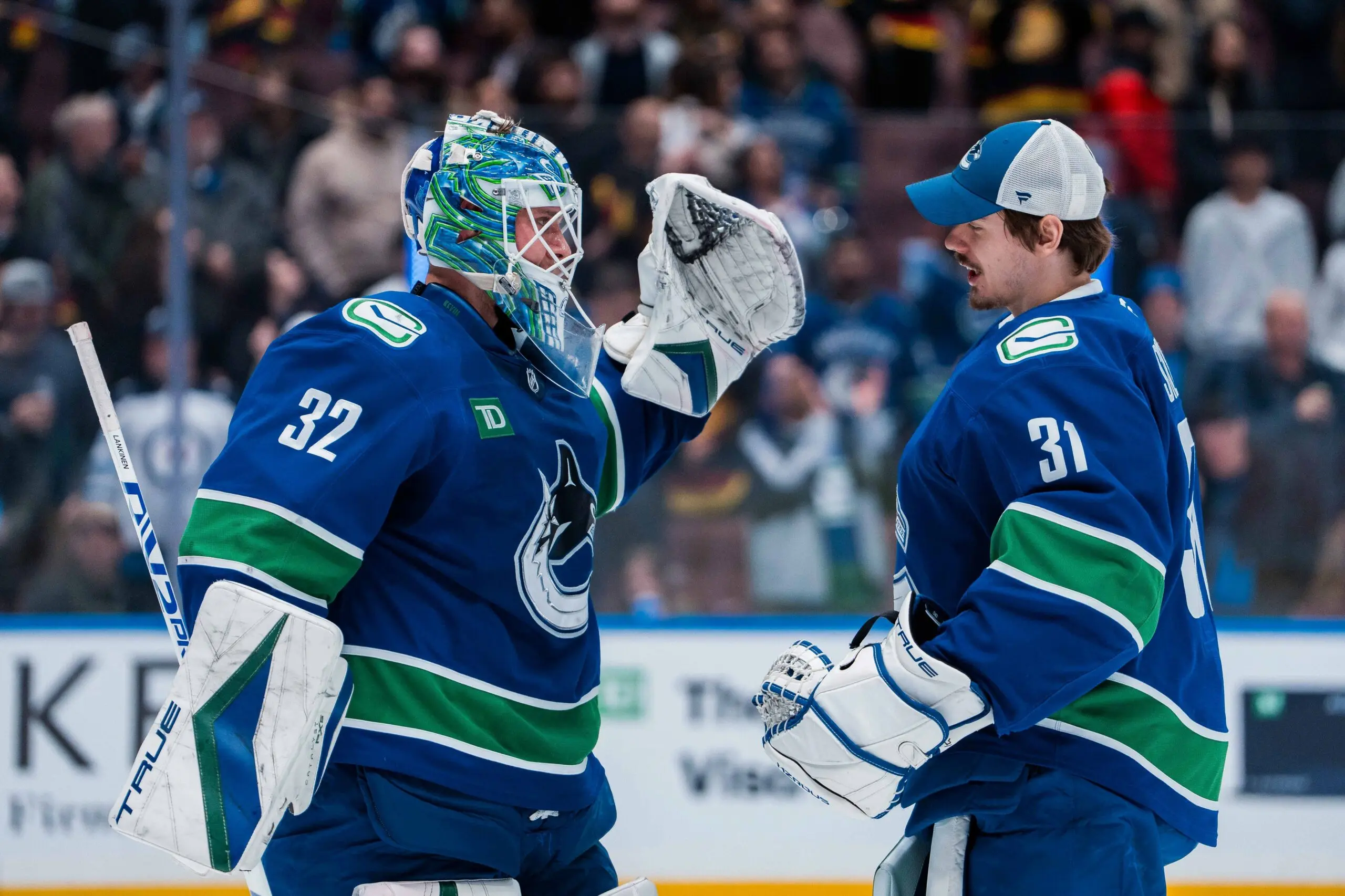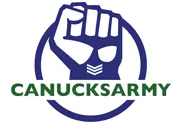Nation Sites
The Nation Network
CanucksArmy has no direct affiliation to the Vancouver Canucks, Canucks Sports & Entertainment, NHL, or NHLPA
Could Arturs Silovs’ performance and waiver status push the Canucks toward a Thatcher Demko trade?

Photo credit: © Bob Frid-Imagn Images
Jun 1, 2025, 13:23 EDTUpdated: Jun 2, 2025, 12:27 EDT
We’d be calling it the ‘Summer of Silovs,’ if we hadn’t already experienced a couple of Summers of Silovs already.
Whether it be the World Championships, the Stanley Cup Playoffs, or the AHL’s Calder Cup Playoffs, Arturs Silovs really does seem to play his best hockey when the weather gets warmer. As most of you know, he’s currently got the Abbotsford Canucks in a 2-0 series lead over the Texas Stars for the AHL’s Western Conference Finals, and referring to him as the team’s postseason MVP thus far might be putting it lightly.
Of the ten Abbotsford playoff wins so far, five have come as a result of Silovs shutouts. His ten wins, .941 save-percentage, and 1.61 goals-against-average are all tops in the AHL by considerable margins.
The 24-year-old Latvian netminder isn’t just playing well. He’s playing so extremely well that it almost can’t help but to impact the Vancouver Canucks’ overall plans for their goaltending, and perhaps as soon as this very offseason. They approach the 2025/26 with all three of Silovs ($850,000), Thatcher Demko ($5,000,000), and Kevin Lankinen ($4,500,000) under contract.
Here’s the thing: Silovs’ waiver exemption – which had previously prevented him from needing to be placed on the waiver wire before being sent down to Abbotsford – runs out as of this offseason. That means that, as of the 2025/26 season, Silovs either stays in Vancouver or gets exposed on waivers at some point between the open of Training Camp 2025 and the close, free for any of the other 31 franchises to claim.
And make no mistake – he would be claimed. Despite a tough run in the NHL last year, Silovs remained the Canucks’ top goaltending prospect, and this epic run for Abbotsford only solidifies it. There is, in general, a dearth of available goalies right now and especially heading into the offseason. There are a small handful of even full-time NHL-capable netminders hitting the UFA market, and perhaps a smaller handful available through trade. Some team is going to come up short in their search, and that team – or teams, more likely – would probably love to be able to pick up someone of Silovs’ calibre for absolutely free in early October.
Which, to be clear, is an unacceptable outcome. The Canucks have spent six seasons developing Silovs to this point where he’s now a goaltender with some real value and continued potential. To give up a talent like that for nothing would be a real tragedy in asset management. Is there risk that Silovs will, as he did in 2024/25, struggle with NHL regular season duty in 2025/26? Sure. But that doesn’t add up to the risk of giving away a potential star goalie for free to a rival organization. Suffice it to say, then, that Silovs will not hit waivers, and that the Canucks will find another way to resolve the situation.
From where we’re sitting, they’ve got a number of other options, each of varying likelihood.
The Canucks could run a roster with three goaltenders next season. It’s rare, but it happens – pretty much exclusively in situations like this, where a team has two established veteran goalies but doesn’t want to lose a third, younger goalie on waivers.
But it’s a less-than-ideal situation for a few reasons. One is the awkwardness in managing playing time between the three, especially with Silovs still being young enough to need consistent reps in order to develop further. Another is the cost of a roster spot and a little bit of cap space, both of which are often in high demand in Vancouver.
This option also does nothing to move the Canucks closer to any sort of resolution. The three-goalie rotation, as a result, seems an improbable path for them to go down.
So, if Silovs hitting waivers and the three-goalie rotation belong in the ‘highly unlikely’ category, we’re left with the third and far most likely option, for our money: a trade.
The Canucks could trade any of their three goalies. But, to be clear, we don’t think each has an equal likelihood of being traded.
Silovs himself could be traded. If he’s the kind of asset that multiple teams might claim on waivers, that suggests that teams would also be willing to trade at least some draft picks for the exclusive chance to acquire him.
But goalies without long track records don’t tend to bring in major returns in trades, even after a legendary postseason AHL run. That the San Jose Sharks traded a protected Vegas first, a recent first round pick in David Edstrom, and a minor league goalie for Yaroslav Askarov last season might give some Canucks supporters hope of landing a big package for Silovs – or of somehow translating him into a top-six centre. But Askarov was both significantly younger than Silovs, and had the pedigree of having been the 11th overall pick in 2020 and being considered the world’s top goalie prospect ever since.
Silovs and Askarov are not in the same tier, trade-value-wise.
If the Canucks were able to get a first round pick or something of that equivalence back for Silovs, well then of course a trade has to be on the table. But that doesn’t seem very likely, especially not with the Canucks being somewhat forced into a decision by the pending arrival of waivers. Is just a second rounder worth considering? That gets tricky. Then, anything less than that, and we’re firmly into ‘not worth it’ territory.
The Canucks could consider trading Lankinen, too. There will be enough teams out there seeking starters or tandem-starters to create a market for his services, new contract and all.
But that new contract also makes a trade excessively unlikely. For one, signing someone to a four-year extension and then trading them before it even kicks in is considered to be decidedly bad form. It’s the kind of thing that gets one’s phone taken away in the EA Sports world. And as of July 1, Lankinen’s two years of full no-movement clause kick in.
There is technically nothing stopping the Canucks from trading Lankinen right now, before the clause takes effect, unless they’ve made a handshake agreement specifically not to do that. But even if there were no agreement in place, that’s a fairly greasy move that would no doubt have a chilling effect on other players being willing to sign extensions. It also doesn’t seem like GM Patrik Allvin’s style.
The Canucks could wait until Lankinen’s NMC begins, and then ask him about a trade, but that seems a bit silly. It’s a bad place to start trade talks from, with the player in full control of their destination, and if Lankinen winds up staying, it’s pretty awkward to begin a four-year extension with the team telling the player they’d like to trade them.
Lankinen, as a result, is even less likely to be traded than Silovs.
Which leaves us with Thatcher Demko.
Demko isn’t the Canucks’ oldest goalie – he’s about eight months younger than Lankinen. But he is the goalie with by far the most question marks when it comes to his health; past, present, and future.
Demko is also about to enter the last year of his current contract at a cap hit of $5 million – and, notably, absolutely no trade protection whatsoever.
As of July 1, the Canucks will have a chance to open up extension talks with Demko, and that will let them know where he and his camp stand on salary and term demands. If, that is, Demko even makes it that far.
From where we sit, trading Demko is by far the Canucks’ most likely resolution to their three-goalie problem (not that it’s necessarily a problem, we just wanted to make reference to The Three-Body Problem, relax).
Conversely to his health woes and contract status, Demko remains the Canucks goaltender with the greatest trade value. He is just one year separated from a Vezina nomination, and that opens him up to a whole different category of suitor. Teams with a spot open for a young goalie with potential might consider Silovs, and teams who just need someone capable of starting might consider Lankinen, but those teams in need of a true difference-maker could only really consider Demko. And there are a number of teams out there who are and will be looking for a difference-maker in net.
Even with a single year remaining on his contract, even with a bum popliteus, even with the Canucks in a mildly awkward spot with their three-goalie juggle, Demko’s trade value starts at a first round pick and only goes up from there, depending on how many teams bid on him. Take a look at the other goalies available this offseason and realize that Demko is easily the best of them, and perhaps the only one that teams could reasonably convince themselves is capable of transforming them into a more competitive team.
The market will be there. Trading Demko thus ensures the greatest return for the Canucks, avoids the risk of Silovs getting anywhere near the waiver wire, and continues to commitment to Lankinen that was made last season.
We won’t go as far as to say a Demko trade is the Canucks’ only option this offseason. But it does look like, by far, the option that has the most likelihood of coming to pass.
If that wasn’t the case before, it certainly is following Silovs’ shutdown performance on the very cusp of his waiver-exemption running dry.
Sponsored by bet365
Recent articles from Stephan Roget
Breaking News
- The Stanchies: Canucks nearly ruin the perfect tank game, still find a way to lose 5-3 to Sabres
- Instant Reaction: Canucks battle back to make it close, but fall 5-3 to Sabres
- ‘Do it for once, please’: Jannik Hansen wants the Canucks to sell high and trade Kiefer Sherwood
- Blackfish: Abbotsford Canucks’ post-holiday road work, World Junior medals, and a CHL trade watch
- Canucks prospect Parker Alcos traded to the Kelowna Rockets: report
